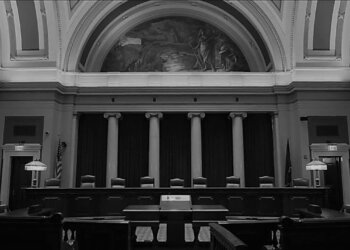The first time, it was unexpected. After that first time, you anticipate it—the sound of someone crying or the sight of someone’s eyes welling up with tears as you speak about treatment issues facing America’s returning combat veterans. The pain is real and the release of tears for that parent, child, or in-law of a combat veteran is understandable because—finally—someone is talking about what they have been living with since their solider returned home. And they’re learning that our justice system can provide help, and hope, through our Veterans Treatment Courts.
According to a recent RAND Corporation study, over 2.7 million service members have served on over 5 million deployments in the combat theaters of Iraq and Afghanistan since 9/11. Approximately 10 percent of those service members have served three or more deployments. Whatever the cost to the nation’s treasury, the true toll of these wars is the human one.
Many service members return home with injuries we cannot see. A 2008 RAND study concluded that nearly 20 percent of service members returning from Iraq and Afghanistan reported symptoms of post-traumatic stress disorder (PTSD) or major depression. Nineteen percent reported that they may have suffered a traumatic brain injury (TBI) while deployed. For those veterans battling the invisible wounds of war, there is often a co-occurring substance abuse disorder. In turn, families and communities are also deeply affected.
In 2008, Judge Robert Russell of Buffalo, NY, noticed an increase in the number of veterans coming into the criminal justice system. Recognizing that significant numbers of veterans were returning from combat zones experiencing symptoms related to TBI, PTSD, and depression, Judge Russell designed and implemented the nation’s first Veterans Treatment Court to help address the unique difficulties facing justice-involved veterans. An important aspect of his program involved helping veterans utilize the benefits and treatment available to them as a result of their service, including Veterans Administration (VA) resources that might not be otherwise available at the local level.
Recognizing that significant numbers of veterans were returning from combat zones experiencing symptoms related to TBI, PTSD, and depression, Judge Russell designed and implemented the nation’s first Veterans Treatment Court to help address the unique difficulties facing justice-involved veterans.”
Two years later, Judge Jerry Ault of the Mansfield Municipal Court established the third Veterans Treatment Court in the nation and the first in Ohio. During that same time, former Ohio Supreme Court Justice Evelyn Stratton was appointed to a VA committee to help create the Veterans Justice Outreach program. She also began the Veterans Wrap Around Project, a management tool that organized the different resources available to justice-involved veterans. By 2012, Ohio had added five Veterans Treatment Courts. Today, there are 19 certified treatment courts serving the needs of justice-involved veterans in 14 counties, with three more courts in the process of certification. And judges without a certified treatment court are finding alternative pathways to access specialized treatment for justice-involved veterans. But there is more to do.
If you spend time talking with Ohio judges about the complex treatment issues justice-involved veterans bring into the criminal justice system, you quickly realize that not all judges have the same breadth of knowledge about those issues or the specialized treatment options available. What all Ohio judges do have, however, is a commitment to justice; we can meet that commitment and best serve our communities by—when appropriate—including in sentencing provisions access to specialized treatment honed for justice-involved veterans.
On August 30, 2018, 37 Ohio judges attended the “Lean Forward—Advancing Veterans Treatment Courts” conference sponsored by the Ohio State Bar Association and its Military and Veterans Affairs Committee, in partnership with the American Legion and AMVETS, two veterans service organizations. Judges learned how to more accurately identify justice-involved veterans, develop a certified treatment court, partner with neighboring certified treatment courts by way of a memorandum of understanding, and infuse treatment court concepts into a regular docket. Armed with that knowledge, Ohio judges will be able to make an informed decision on how best to serve justice-involved veterans who appear before them. Make no mistake: treating justice-involved veterans is not about whether they will be held accountable. They will be. But when sentencing involves community-control sanctions, courts should offer the best specialized treatment available to mitigate the trauma of war.
Helping a veteran does not start and stop at the courthouse door. Law firms and private practitioners can also help current or former service members by providing pro bono legal services through Operation Legal Help Ohio or by becoming certified to handle appeals of the denial of VA benefits or less-than-honorable discharges. In addition, veterans can become peer mentors.
We all long for the day when the men and women of our armed services are not put into harm’s way or sent around the globe to undertake the herculean effort to do that which they are called to do—anything necessary to stop an aggressor or foe. But until that day, we should all “lean forward” into the challenges the invisible injuries of war present to our veterans, develop strategies to connect those veterans to treatment, and take action in order to ensure that those who have served our country not just return home, but return wholly home. Justice Sharon L. Kennedy









